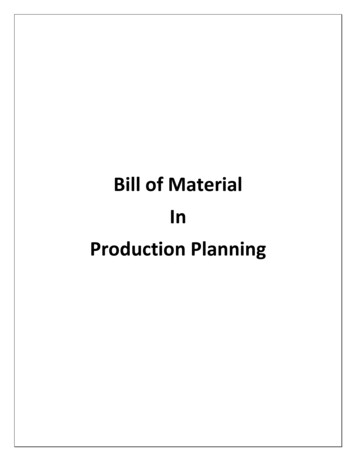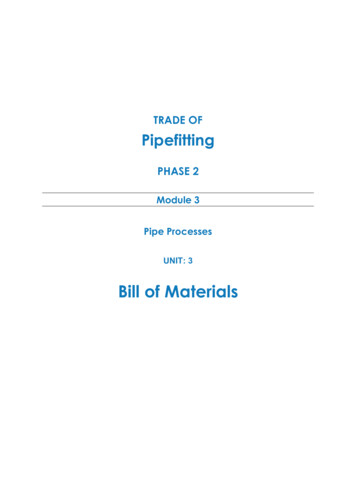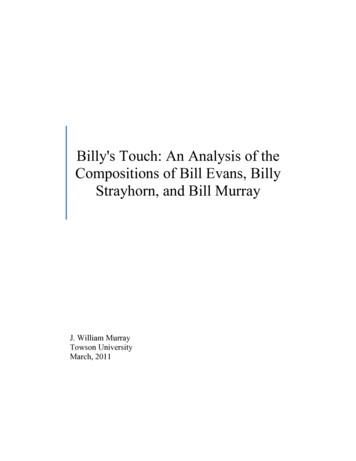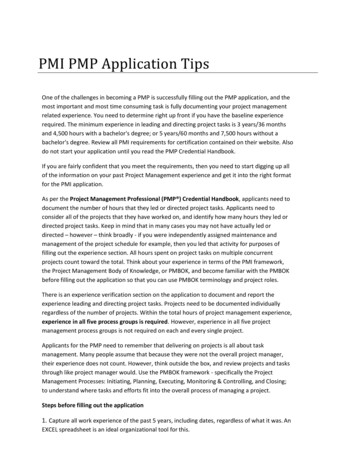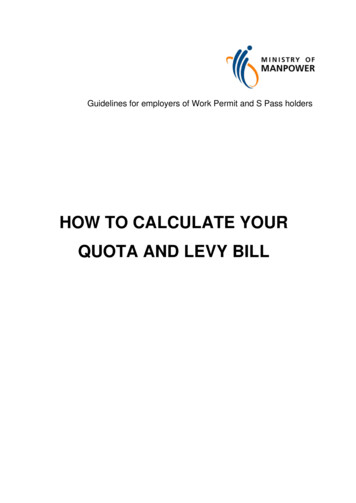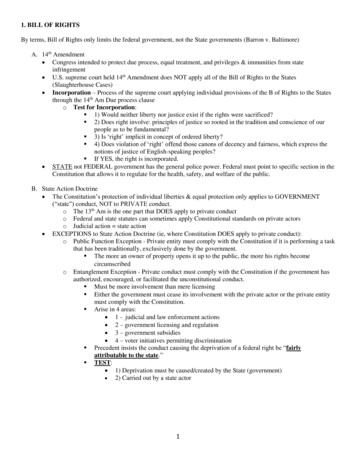
Transcription
1. BILL OF RIGHTSBy terms, Bill of Rights only limits the federal government, not the State governments (Barron v. Baltimore)A. 14th Amendment Congress intended to protect due process, equal treatment, and privileges & immunities from stateinfringement U.S. supreme court held 14th Amendment does NOT apply all of the Bill of Rights to the States(Slaughterhouse Cases) Incorporation – Process of the supreme court applying individual provisions of the B of Rights to the Statesthrough the 14th Am Due process clauseo Test for Incorporation: 1) Would neither liberty nor justice exist if the rights were sacrificed? 2) Does right involve: principles of justice so rooted in the tradition and conscience of ourpeople as to be fundamental? 3) Is ‘right’ implicit in concept of ordered liberty? 4) Does violation of ‘right’ offend those canons of decency and fairness, which express thenotions of justice of English-speaking peoples? If YES, the right is incorporated. STATE not FEDERAL government has the general police power. Federal must point to specific section in theConstitution that allows it to regulate for the health, safety, and welfare of the public.B. State Action Doctrine The Constitution’s protection of individual liberties & equal protection only applies to GOVERNMENT(“state”) conduct, NOT to PRIVATE conduct.o The 13th Am is the one part that DOES apply to private conducto Federal and state statutes can sometimes apply Constitutional standards on private actorso Judicial action state action EXCEPTIONS to State Action Doctrine (ie, where Constitution DOES apply to private conduct):o Public Function Exception - Private entity must comply with the Constitution if it is performing a taskthat has been traditionally, exclusively done by the government. The more an owner of property opens it up to the public, the more his rights becomecircumscribedo Entanglement Exception - Private conduct must comply with the Constitution if the government hasauthorized, encouraged, or facilitated the unconstitutional conduct. Must be more involvement than mere licensing Either the government must cease its involvement with the private actor or the private entitymust comply with the Constitution. Arise in 4 areas: 1 - judicial and law enforcement actions 2 – government licensing and regulation 3 – government subsidies 4 – voter initiatives permitting discrimination Precedent insists the conduct causing the deprivation of a federal right be “fairlyattributable to the state.” TEST: 1) Deprivation must be caused/created by the State (government) 2) Carried out by a state actor1
2. ECONOMIC LIBERTIES Due Process Clauseso 5th Am – Applies to FEDERAL governmento 14th Am – Applies to STATE/LOCAL government Contracts Clause (Art. 1, sec. 10) Takings Clause (5th Am)A. Due Process Clauses: The US supreme court has spoken of two types of “Due Process”:o 1) Procedural Due Process – the procedures the government must use if it takes away “life, liberty orproperty” In particular, government must provide adequate NOTICE and HEARINGo 2) Substantive Due Process – whether the government has adequate REASON to take life, liberty, orproperty Substantive Due Process:o Economic Substantive Due Process – protects economic liberties – eg, right to contract freely withoutexcessive government interference As of today, Economic SDP does NOT give any extra protection – ie, Court givesRATIONAL BASIS review to laws affecting economic rightso Non-Economic Substantive Due Process – eg, protects privacy & autonomy rights As of today, Non-Economic SDP gives extra protection to SOME rights – ie, Court givesHEIGHTENED review (eg, strict scrutiny) to some rightsB. Contracts Clause (Art. I, sc. 10) Applies to:o Existing contracts only (not future)o STATE/LOCAL governments only Test: When a state or local government interferes with existing private contracts, a three-part test is used:1. Is there a substantial impairment of a contractual relationship;2. If so, does it serve a significant and legitimate government purpose;3. If so is it reasonably related to achieving the public goal? As of today, the Contracts Cl gives little extra protection – ie, the standard of review for the State/Local lawaffecting a contract is RATIONAL BASISo EXCEPTION: where the government itself is a party to the contract, the Court will apply heightenedscrutinyC. Takings Clause (5th Am) 5th Am: “nor shall private property be taken for public use, without just compensation.” Both federal and state governments have power of EMINENT DOMAINo Eminent Domain: authority to take private property when necessary for government activities. Acts as a limit on the government sovereign power of eminent domain (ie, the government’s authority to seizeprivate property for its own use) Test:o 1) Is there a “taking”? yes, where government physically takes property yes, where government regulation deprives virtually all economically beneficial useso 2) Is it for “public use”? If not for public use, must give property back Taking is for public use as long as it meets the rational basis testo 3) What is “just compensation”? Just compensation measured in terms of the loss to the owner; the gain to the taker isirrelevant typically, fair market value2
3. EQUAL PROTECTIONA. Equal Protection Clause (14th Am) “nor Shall any State deny to any person within its jurisdiction the equal protection of the laws.” Applies to State AND Federal governments (Boiling v. Sharpe) Equal Protection Analysis:o 1. What is the classification? If classification exists on FACE of law, go to 2. If law is facially NEUTRAL, level of scrutiny is RATIONAL BASIS, UNLESS discriminatory PURPOSE is shown (is so, go to 2)o 2. What is the appropriate level of scrutiny? Strict Scrutiny (heightened scrutiny): “Suspect Class” – Race, National Origin, Alienage* (*except when related to “selfgovernment & democratic process”, then rational basis) Fundamental Right – eg, Right to vote, Bill of Rights, etc. Intermediate Scrutiny (heightened scrutiny): “Suspect Class” – Gender, Non-marital children Rational Basis (default standard) Everything elseo 3. Does the government action meet the level of scrutiny? Evaluate whether appropriate “means” and “end” are satisfied Government MUST be using the LEAST restrictive alternative in order to win Court focuses on degree to which a law is overinclusive and/or underinclusive Underinclusive – When laws do not regulate all who are similarly situated Overinclusive – Law covers more people than it needs to in order to accomplish its purpose Just because a law is under/overinclusive does not mean it is sure to be invalidated.B. Standard of Review Rational Basis (default)o Law/action is presumed constitutional, ie, challenger has burden of proof to overcome lawo Challenger must show that the law/action is NOT rationally related to a legitimate government interest.o TEST: Two questions: 1. Does the law have a legitimate purpose? 2. Is the law rationally related to achieving that purpose?o Legitimate Purpose Legit purpose if law advances a traditional “police” purposeo Requirement for a “Reasonable Relationship”o Significant over/underinclusion is acceptable under rational basis testo If challenged law, argue the law is arbitrary and/or unreasonableo Age, disability, wealth, and sexual orientation permit only rational basis review Intermediate Scrutinyo Law/action is presumed Unconstitutional; burden of proof shifts to governmento Government must show that the law/action substantially advances an important government interest Strict Scrutinyo Law/action is presumed Unconstitutional; burden of proof shifts to governmento Government must show that the law/action is necessary (or NARROWLY TAILORED) to accomplish acompelling government interest.o If there is any less discriminatory alternative, the law/action FAILSo Federal immigration laws wholly occupy the field and preempt state efforts to regulate immigration.o Strict scrutiny is used to evaluate discrimination against non-citizens Alienage classifications relating to self-government and democratic process only need meet rationalbasis reviewo Two major principles: 1) laws that provide a benefit to all marital children but NO non-marital children, ALWAYS aredeclared unconstitutional 2) laws that provide a benefit to SOME non-marital children, while denying the benefit to other nonmarital children are evaluated on a case-by-case basis under intermediate scrutiny3
Criteria for determining which level to use:o Immutable characteristics warrant heightened scrutiny (no control over characteristics) Race, origin, gender, marital status of parentso Ability of the group to protect itself through the political process Minoritieso History of discrimination against the groupo Do not need all of these, but usually a combination of these factorsC. Facially Neutral Laws with a Discriminatory Impact or Discriminatory Administration Showing a discriminatory purpose requires proof that the government desired to discriminate; not enough to prove thegovernment took action with knowledge that it would have discriminatory consequenceso Law must be enacted “because of”, not “in spite of” discrimination to be unconstitutional.4
4. SUBSTANTIVE DUE PROCESSA. Due Process Analysis1. Is there a Fundamental Right (or Constitutionally-protected liberty interest)? Ie, Is it deeply rooted in traditions and conscience of our people?o If YES, strict scrutiny applies, go to 2.o If NO, rational basis applies, go to 3.2. Is the Constitutional Right infringed?o Ie, is infringement “substantial & direct”? If YES, go to 3 If NO, rational basis applies, go to 3.3. Is the Standard of Review met?o Is there sufficient justification (purpose) for government action?o Is the means sufficiently related to the purpose?B. Fundamental Rights Rights/Interests recognized by Supreme Courto Rights expressly protected in the Bill of Rightso Family Autonomy Right to Marry Right to Custody of One’s Own Children Right to Keep Family Together Right to Control Upbringing of Childreno Reproductive Autonomy Right to Procreate Right to Purchase/Use Contraceptives Contraception is a constitutionally protected right (not fundamental per se) because it fallswithin the right of privacy, located in the penumbra of the Bill of Rights, also in the DueProcess Clause. Right to Abortion (applies hybrid test)o Medical Care Decisions Right to Refuse Unwanted Medical Treatment (applies undefined form of heightened scrutiny) Right to Physician-Assisted Suicide (NO – THIS IS NOT A FUNDAMENTAL RT)o Sexual Activity Right to Privacy of Sexual Activity (applies undefined form of heightened scrutiny)o Implicit right of privacyo Travelo Voteo Access to Courtso Supreme Ct has REFUSED to recognize a fundamental right to educationC. Right to Abortion Test for abortion:o Does the law impose an “UNDUE BURDEN” on a woman’s ability to make this decision? If yes, unconstitutional To determine undue burden: Purpose or effect of the law is to impose a “SUBSTANTIAL OBSTACLE” While a woman has the right to CHOSE abortion, she does not have the right TO abortion in the sense that the states donot have an obligation to fund abortions Spousal notice is an undue burden because of potential domestic violence State may require parental notice or consent for unmarried minor’s abortion, ONLY IF there is a judicial alternativewhere a judge can approve if in the minor’s best interest is mature enough to decide for herselfD. Right to Medical Care Decisions Right to Refuse Treatmento Not absolute and can be regulated by the states.o State may require clear and convincing evidence that a person wanted treatment terminated. Court does notindicate what type of evidence might be sufficient to meet this proof. Right to Physician-Assisted Suicideo NOT a fundamental right or liberty interest5
5. PROCEDURAL DUE PROCESSA. Procedural Due Process Analysis 1. Is there a Deprivation?o Governmental Negligence – NOo Governmental Failure to Act – NOo Governmental Reckless Indifference – YES UNLESS there is an emergency – NO UNLESS there is arbitrary government action that shocks the conscience –YESo Ie, a purpose to cause harm unrelated to legitimate government interest 2. Is it a deprivation of life, liberty, or property? 3. What procedures are required?o Adequate Notice & Hearing To determine “Adequacy of Hearing”, ask: A. What is the PRIVATE interest? (Importance of the interest involved) B. What is the risk of error with the current process, and probable value of additionalprocess? (Degree to which the procedure will make a difference) C. What is the GOVERNMENT interest? For government employee, a full hearing is not necessary when firing an employee from a government job.6
6. FREEDOM OF SPEECHA. Analysis 1. Does it regulate “speech”?o a. Is “conduct” communicative? Spence v. Washington Test – Communicative (expressive) when: Speaker intends to convey a particular message Likelihood is great that message is understood by those who view it If no, 1st Am doesn’t protect it If yes, go to b.o b. When may government regulate communicative conduct? (US v. O’Brien Test) within power of the government furthers an important, substantial government interest government interest is unrelated to suppressing speech restriction is no greater than essential 2. Is it content-based or content-neutral?o a. if content-based, strict scrutiny applies Content-based can be based either on: The SUBJECT of the speech, and/or The VIEWPOINT of the speecho b. if content-neutral, intermediate scrutiny applies reasonable time, place, and manner restrictions (alternatives) may be usedo Knotty issues: Secondary effects Where government must make choices based on content (eg, subsidy) – cannot be viewpointbased 1st Am does not apply to government speech (eg, permanent monument in park) 3. Is it vag
B. Contracts Clause (Art. I, sc. 10) Applies to: o Existing contracts only (not future) o STATE/LOCAL governments only Test: When a state or local government interferes with existing private contracts, a three-part test is used: 1. Is there a substantial impairment of a contractual relationship; 2. If so, does it serve a significant and legitimate government purpose;



